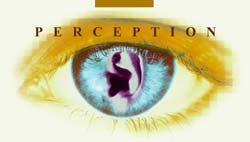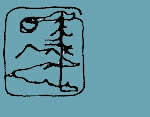
| go to fall quarter |
| home |
| announcements |
| syllabus |
| assignments |
| resources |
| contacts |
 |
 |
Contour drawing: an approach taken from Drawing on the Right Side of the Brain by Betty Edwards
USING PURE CONTOUR DRAWING
TO BYPASS YOUR SYMBOL SYSTEM
In my classes, I demonstrate pure contour drawing, describing how to use the method as I draw - if I can manage to keep talking (an L-mode function) while I’m trying to use my right brain for drawing. Usually, I start out all right but begin trailing off in mid-sentence after five minutes or so. By that time, however, my students will have the idea.
Following the demonstration, I show examples of previous students’ pure contour drawings.
Before you begin: To best achieve an approximation of the classroom procedure, be sure to read all of the instructions ... before beginning your drawing.
1. Find a place where you can be alone and uninterrupted for at least twenty minutes.
2. Set an alarm clock or timer, if you wish, for twenty minutes just before you start your drawing. (This is to remove the necessity of keeping track of time — an L-mode function.) Or, if you have plenty of time and don’t care about how long you might be drawing, omit the timer.
3. Place a piece of paper on a table and tape it down in any position that seems comfortable. Taping is necessary so that the paper won’t shift about while you are drawing.
4. You are going to draw a picture of your own hand — your left hand if you are right-handed, your right hand if you are left-handed. Arrange yourself so that your drawing hand, holding the pencil, is ready to draw on the taped-down paper.
5. Face all the way around to the opposite direction, gazing at the hand you will draw. Be sure to rest the hand on some support, because you will be holding the same position for quite a long time. You are going to draw your hand without being able to see what you are drawing (see the position in Figure 6-1). Facing away from your drawing is necessary to achieve the purpose of the method: first, to focus your entire attention on the visual information out there in front; and second, to remove all attention from the drawing, which might trigger off your old symbolic patterns memorized from childhood as the “way to draw hands.” You want to draw only what you see (in spatial R-mode) and not what you know (in symbolic L-mode). Turning all the way around is necessary also because the impulse to look at the drawing is almost overwhelming at first. If you draw in the normal position and say to yourself, “I just won’t look,” you will very likely find yourself stealing peeks out of the corner of your eye. This will reactivate the L-mode and defeat the purpose of the exercise.
6. In the turned-around position, focus your eyes on some part of your hand and perceive an edge. At the same time, place the point of your pencil on the paper (at any place well within the outside borders of the paper).
7. Very slowly, creeping a millimeter at a time, move your eyes along the edge of your hand, observing evey minute variation and undulation of the edge. As your eyes move, also move your pencil point at the same slow pace on the paper, recording each slight change or variation in the edge that you observe with your eyes. Become convinced in your mind that the information originating in the observed object (your hand) is minutely and precisely perceived by your eyes and is simultaneously recorded by the pencil, which registers everything you are seeing at the moment of seeing.
8. Do not turn around to look at the paper. Observing your hand, draw the edges you see one bit at a time. Your eyes will see and your pencil will record bit by bit the changing configuration of the contour. At the same time you will be aware of the relationship of that contour to the whole configuration of complex contours that is the whole hand. You may draw outside or inside contours or move from one to the other and back again. Don’t be concerned about whether the drawing will look like your hand. It probably won’t, since you can’t monitor proportions, etc. By confining your perceptions to small bits at a time, you can learn to see things exactly as they are, in the artist’s mode of seeing.
9. Match the movement of the pencil exactly with your eye movement. One or the other may attempt to speed up, but don’t let that happen. You must record everything at the very instant that you see each point on the contour. Do not pause in the drawing, but continue at a slow, even pace. At first you may feel uneasy or uncomfortable: some students report sudden headaches or a sense of panic. I believe this happens when the left brain senses that pure contour drawing is presenting a serious challenge to its dominance. It realizes, I think, that if you record the intricate, complex tangle of edges in your hand at the slow pace you are drawing, the right brain will have control for a long, long time. Therefore, the left brain says, in effect, “Stop this stupid stuff right now! We don’t need to look at things that closely. I’ve already named everything for you, even some small things like wrinkles. Now be reasonable and let’s get on with something that’s not so boring — if you don’t, I’ll give you a headache.”
Ignore this complaining. Simply persist. As you continue to draw, the protests from the left will fade out and your mind will become quiet. You will find yourself becoming fascinated with the wondrous complexity of the thing you are seeing, and you will feel that you could go deeper and deeper into the complexity. Allow this to happen. You have nothing to fear or be uneasy about. Your drawing will be a beautiful record of your deep perception. We are not concerned about whether the drawing looks like a hand. We want the record of your perceptions.
After you finish: Think back now on how you felt at the beginning of the pure contour drawing compared to how you felt later, when you were deeply into the drawing. What did that later state feel like?